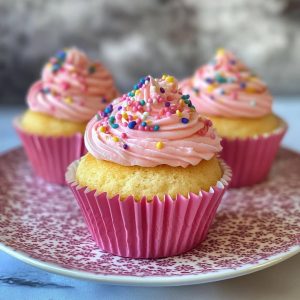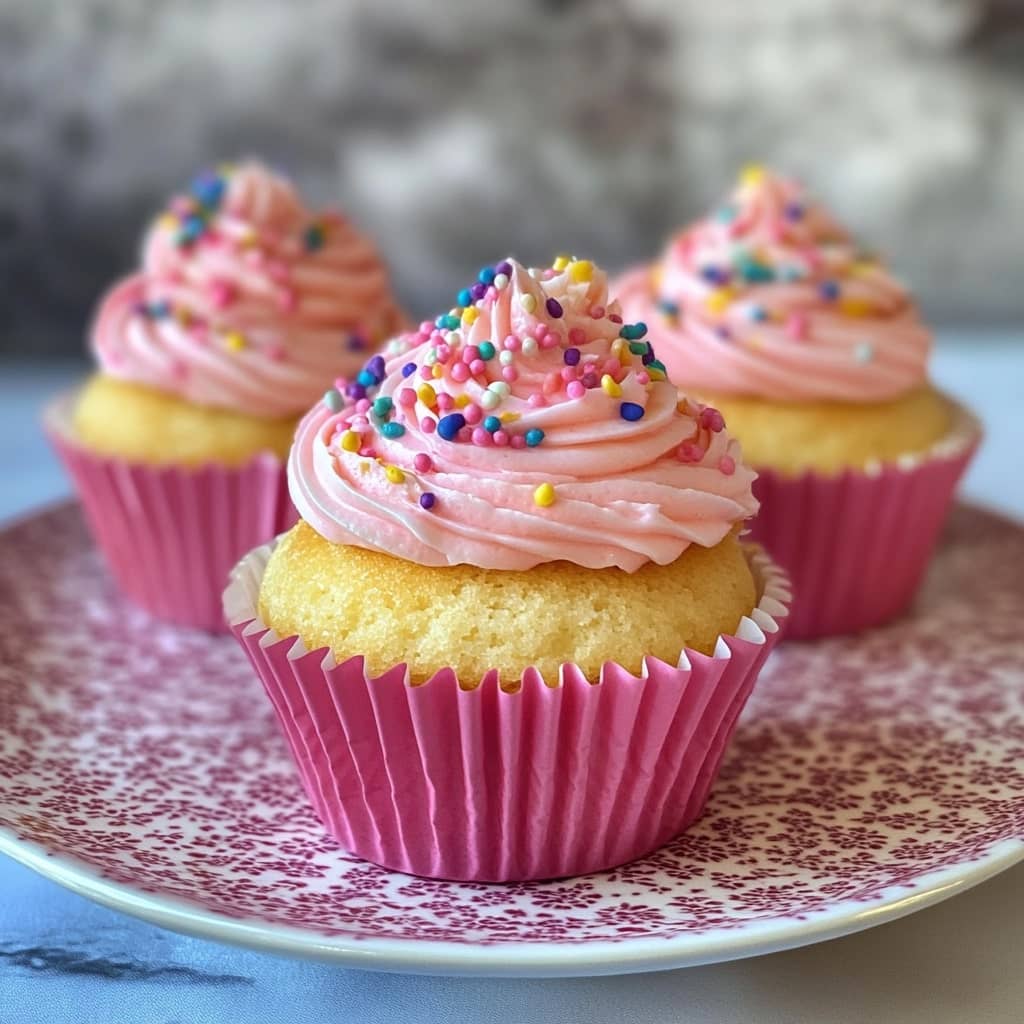Vanilla cupcakes are a beloved classic in the world of desserts, cherished for their light, fluffy texture and subtly sweet flavor that makes them ideal for nearly any occasion. Whether served at birthdays, weddings, afternoon teas, or simply enjoyed as a treat at home, vanilla cupcakes have stood the test of time as a staple of home baking and professional patisserie alike. The simplicity of the vanilla cupcake is what gives it its charm, allowing it to be a versatile base for frostings, fillings, and decorations of every kind, from buttercream swirls to fondant figurines. Their enduring popularity owes much to their universal appeal, ease of preparation, and the sense of nostalgia they often bring with every bite.
The History of Vanilla Cupcakes
The cupcake, originally known as the “number cake” or “1234 cake” due to its easy-to-remember ratio recipe (1 cup of butter, 2 cups of sugar, 3 cups of flour, 4 eggs), began gaining popularity in the United States in the late 18th and early 19th centuries. They were first mentioned in Amelia Simmons’ 1796 cookbook American Cookery, the first known American cookbook. The term “cupcake” itself was coined in the early 1800s, referring both to the measurement of ingredients by the cup and the practice of baking the cakes in individual pottery cups or ramekins before muffin tins became widespread. Vanilla, as a flavoring, became widely available in the 19th century thanks to the cultivation of vanilla orchids in regions like Madagascar and Mexico. The vanilla cupcake as we know it today—moist, fluffy, and delicately scented with real vanilla—emerged from these culinary innovations and became an instant classic in American baking culture, further cemented by commercial baking mixes and the rise of cupcake-focused bakeries in the 2000s.
Ingredients Breakdown
To achieve the perfect vanilla cupcake, the quality and ratio of ingredients are crucial. All-purpose flour provides structure, while baking powder and baking soda are leavening agents that ensure the cupcakes rise evenly with a tender crumb. Unsalted butter adds richness and moisture and is best when creamed with sugar to incorporate air for a light texture. Granulated white sugar sweetens the cupcakes and helps create a golden crust. Eggs are essential for binding and also contribute to leavening. Whole milk or buttermilk keeps the cupcakes moist and soft, while the slight acidity in buttermilk can tenderize the flour and activate the baking soda. Pure vanilla extract is the star of the show, infusing the cupcakes with a warm, aromatic flavor that defines the entire experience. Optional ingredients like salt enhance the sweetness and balance the flavor profile, while a bit of sour cream or yogurt can be added for extra richness and moisture.
Step-by-Step Recipe
- Preheat the oven to 350°F (175°C) and line a standard 12-cup muffin tin with paper liners. This ensures even heat distribution and makes for easy cleanup.
- Cream the butter and sugar together in a large bowl using an electric mixer on medium speed for about 3-5 minutes until the mixture is light and fluffy. This aerates the batter, resulting in a soft and tender cupcake.
- Add the eggs one at a time, beating well after each addition. Make sure to scrape down the sides of the bowl to ensure everything is evenly combined.
- In a separate bowl, whisk together the dry ingredients: flour, baking powder, baking soda, and salt. This ensures that the leavening agents are evenly distributed throughout the batter.
- Combine the wet ingredients: mix the milk (or buttermilk), vanilla extract, and optional sour cream or yogurt in a measuring cup.
- Alternate adding the dry and wet ingredients to the creamed butter mixture, starting and ending with the dry. Mix until just combined, being careful not to overmix, as this can lead to dense cupcakes.
- Fill each cupcake liner about two-thirds full with batter to allow room for rising without overflowing.
- Bake for 18-22 minutes or until a toothpick inserted in the center comes out clean or with just a few moist crumbs attached.
- Cool the cupcakes in the tin for 5 minutes before transferring them to a wire rack to cool completely. This prevents soggy bottoms and ensures a smooth frosting process.
- Frost and decorate as desired once completely cooled, using a vanilla buttercream, whipped cream, or any topping of your choice.
Tips for the Perfect Vanilla Cupcake
Use room-temperature ingredients to ensure they blend smoothly and evenly into the batter, which promotes a consistent texture throughout. Cream the butter and sugar thoroughly to incorporate air and create a light, tender crumb. Be cautious not to overmix once the flour is added; overmixing activates the gluten in the flour and can lead to tough cupcakes. Invest in quality vanilla extract—pure vanilla, rather than imitation, makes a noticeable difference in flavor. If you’re baking at high altitude, consider adjusting the leavening agents and baking temperature slightly to accommodate the changes in air pressure. Always check the doneness with a toothpick and avoid opening the oven door too early, which can cause the cupcakes to collapse.
Variations and Customizations
While the classic vanilla cupcake is a treat on its own, it also serves as a blank canvas for countless variations. For a citrus twist, add lemon or orange zest to the batter. Fold in mini chocolate chips, berries, or sprinkles for fun and texture. Fill the center of the cupcakes with jam, chocolate ganache, or pastry cream for a surprise in every bite. Swap out the vanilla buttercream for cream cheese frosting, chocolate ganache, or a dollop of whipped cream. For festive occasions, add food coloring to the batter or frosting and top with themed decorations. Vegan and gluten-free versions can be made by substituting dairy and eggs with plant-based options and using gluten-free flour blends. Spices like cinnamon or cardamom can be added to the batter for a warm, aromatic profile, and caramel or espresso infusions create a more gourmet experience.
Health Considerations and Nutritional Value
A standard vanilla cupcake made with butter, sugar, and white flour is a high-calorie treat best enjoyed in moderation. Each cupcake typically contains about 200-300 calories, depending on the size and frosting. They are high in simple carbohydrates and sugars, which can lead to blood sugar spikes, and provide limited fiber and micronutrients. To make them slightly healthier, you can use whole wheat pastry flour for more fiber, reduce the sugar, or substitute with natural sweeteners like honey or maple syrup. Using Greek yogurt or applesauce in place of some butter can cut fat while retaining moisture. Vegan versions using coconut oil or avocado can offer healthier fats, and dairy-free milk like almond or oat milk can accommodate those with lactose intolerance. Portion control is key, and pairing a cupcake with a source of protein or fiber may help moderate blood sugar responses.
FAQ
Can I make vanilla cupcakes ahead of time? Yes, vanilla cupcakes can be baked in advance and stored in an airtight container at room temperature for 2 days, or frozen (unfrosted) for up to 2 months.
Why are my cupcakes dense and dry? This could be due to overmixing, using too much flour, or baking too long. Measuring ingredients accurately and not overworking the batter are key.
Can I substitute oil for butter? Yes, but it will affect both the texture and flavor. Oil makes cupcakes more moist but less rich in flavor.
What kind of frosting goes best with vanilla cupcakes? Classic vanilla buttercream is a favorite, but cream cheese frosting, chocolate ganache, or fruit-flavored frostings also pair well.
How can I make cupcakes rise evenly? Ensure the oven is fully preheated, don’t overfill the liners, and avoid opening the oven door during the first half of baking.
Can I use almond or oat milk instead of dairy milk? Yes, both work well and won’t significantly alter the taste or texture if used in the same proportions.
Do I need to sift the flour? Sifting is optional but recommended to prevent clumping and ensure even mixing, especially when using baking powder or soda.
How do I prevent cupcake liners from peeling off? Let the cupcakes cool completely before storing them, and avoid overbaking or using high-moisture batters.
Can I double the recipe? Yes, but be careful with mixing times and ensure even ingredient distribution for consistent results.

Perfect Vanilla Cupcake
Ingredients
- 1¼ cups of all-purpose flour
- 1¼ teaspoons of baking powder
- ½ teaspoon of salt
- ½ cup of unsalted butter softened to room temperature
- ¾ cup of granulated sugar
- 2 large eggs brought to room temperature
- 2 teaspoons of pure vanilla extract
- ½ cup of buttermilk or plain kefir at room temperature
Instructions
- Preheat your oven to 350°F and line a standard 12-cup muffin or cupcake tin with paper liners. In a medium mixing bowl, whisk together 1¼ cups of all-purpose flour, 1¼ teaspoons of baking powder, and ½ teaspoon of salt, then set the dry mixture aside. In the bowl of a stand mixer fitted with the paddle attachment, or using a handheld mixer, beat the softened butter and sugar together on medium-high speed for about 5 minutes, until the mixture becomes thick, pale, and fluffy, pausing as needed to scrape down the sides of the bowl. Add the eggs one at a time, beating well after each addition and scraping down the bowl between additions to ensure even mixing. Add the 2 teaspoons of vanilla extract and mix until fully incorporated.
- Lower the mixer speed to medium and begin adding the flour mixture in three parts, alternating with the buttermilk. Start and end with the dry ingredients, mixing just until each addition is combined. Be sure to scrape down the sides of the bowl occasionally and stop mixing as soon as the batter is smooth—avoid overmixing to keep the cupcakes light. Evenly divide the batter among the prepared cupcake liners, filling each about two-thirds full. Bake in the preheated oven for 20 to 23 minutes, or until a toothpick inserted into the center of a cupcake comes out clean. Let the cupcakes cool in the pan for about 5 minutes, then carefully transfer them to a wire rack to cool completely before applying your frosting of choice.

